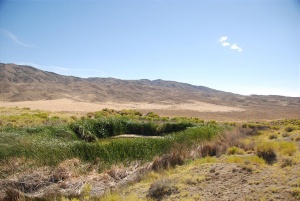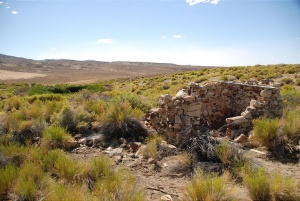Rabbithole Springs: Difference between revisions
No edit summary |
No edit summary |
||
| Line 1: | Line 1: | ||
Rabbit Hole Springs | Rabbit Hole Springs | ||
[[Image:20070816-1656-P15OX-N0407580W1187568--Rabbithole-Springs.jpg|right|thumb]] | |||
[[Image:20070816-1654-P15OW-N0407580W1187568--Rabbithole-Springs.jpg|right|thumb]] | |||
"Great numbers of rabbits came around us and we killed all we wanted of them. This is the place always since known as the Rabbit Hole Springs." Lindsay Applegate, 1846 | "Great numbers of rabbits came around us and we killed all we wanted of them. This is the place always since known as the Rabbit Hole Springs." Lindsay Applegate, 1846 | ||
Revision as of 07:32, 7 February 2008
Rabbit Hole Springs


"Great numbers of rabbits came around us and we killed all we wanted of them. This is the place always since known as the Rabbit Hole Springs." Lindsay Applegate, 1846
- http://www.nevadaoutdoorschool.org/Interpretive_kits_files/Fly%20Canyon/Rabbit%20hole%20Springs.htm www.nevadaoutdoorschool.org/Interpretive_kits_files/Fly%20Canyon/Rabbit%20hole%20Springs.htm
Nevada Outdoor School's emigranthistoryrabbithole.doc
Emigrant History
Water is scarce along the Applegate Trail; however, there were several main locations that emigrants depended upon for their water supply.
These locations were: Antelope Springs, Rabbit Hole Spring, Black Rock Hot Spring, Double Hot Springs, Mud Meadow and High Rock Lake.
During the massive westward emigration in 1849, many emigrants found the spring at Rabbit Hole disappointing. The Applegate’s blazed the trail for the purposes of Oregon-bound emigrants and as an escape route in the event of hostile interaction with the British. The trail was not meant for the passage of thousands of emigrants in 1849. Consequently, Rabbit Hole was less of an oasis and more of a frustration for weary, thirsty travelers. Wells had to be dug in order to retrieve a decent amount of water, and if one arrived later in the day, especially later in the year, the water supply was certain to be low.
Dodd, Charles H. The Emigrant Experience. 19th Century Productions. Chilcoot, CA. 2001. McGuckian, Peggy. Emigrant Trails in the Black Rock Desert. U.S. Department of the Interior Bureau of Land Management. Winnemucca, NV. 1978.